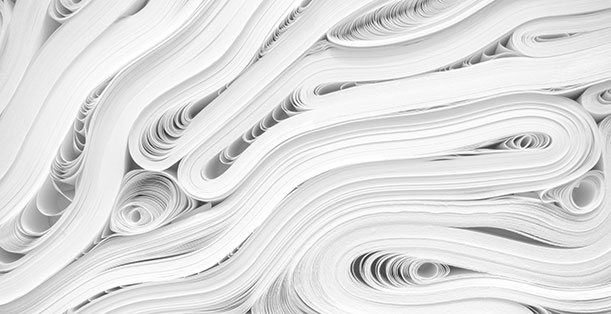BOOMbox at Home: Ingredients of Paper
February 8, 2021

What makes something paper? In technical terms, paper is a writing surface made by first making a mixture of small plant fibers and water called pulp and then pressing it into thin sheets.
All over the world, people have found plants to use as writing surfaces. Some plants are flat enough to write on that they don’t need to be processed into pulp. In South Asia and Southeast Asia, dried palm leaves were used to write manuscripts, like this Buddhist manuscript. Papyrus was a popular plant used to make paper in Egypt by weaving together thin slices of the leaves. Mexican civilizations have been writing with amate paper for thousands of years, which is created from tree bark, making folded books called codexes. Spanish colonizers banned making amate to control indigenous people’s ability to rule themselves and because it was connected to indigenous religion and spirituality. The paper survived because indigenous groups such as the Otomí continued to pass down the tradition in secret.
The paper that most resembles what we use today was developed in China. The invention of paper is credited to Cai Lun, an inventor and court official who lived during the Eastern Han Dynasty (25-220 CE). Before this, many documents were written on bamboo strips. Although some rudimentary form of papers existed earlier, Cai Lun perfected the process. From China, papermaking technology spread to the rest of Asia, the Middle East, and beyond.
Make Your Own Paper
Papermaking allows you to create unique and beautiful objects. The papers mentioned above were made directly from plant fibers, but you can also make paper pulp by recycling used paper. The combination of papers of different colors and textures can make one-of-a-kind sheets. This is an excellent use for junk mail.
Many people who make recycled paper for a hobby use blenders to break up their paper into pulp. We don't recommend using your kitchen blender, as paper can be hard to clean from the blades. You can make paper pulp by hand, soaking paper in bowls of water until it is soft, and then squeezing it into a paste using your hands. The thicker the paper, the longer you will need to let it soak.
Before industrial papermaking processes began, papermakers would shape the pulp using a screen, and hand papermakers still do this. Popular screens include the Japanese suketa, the Nepalese pour mold, and the Western mold and deckle. You can also make your own screen at home. All you need is a frame--like an old picture frame--and a mesh. Old window screens are a popular mesh option as well. Learn how to make a mold and deckle for handmade paper.
Don’t have a blender, and can’t make a mesh? Learn how to make paper with common kitchen supplies.
Make Zucchini Papyrus
The cell walls of plants contain an organic compound called cellulose, which is made of long strings of molecules called glucose. When you break down the cellulose into a pulp with water, some of the glucose dissolves. When the paper pulp dries into a sheet of paper, the glucose reforms and rebonds with cellulose molecules.
Egyptian papyrus wasn’t made with a pulp, rather, by overlapping and drying strips of the papyrus reed plant. That’s what we’re going to be doing with our zucchini. By cooking and pressing strips of zucchini together, you can create bonds from the cellulose molecules. Make zucchini papyrus at home.
Ingredient of the Week
An important part of some papermaking processes includes potato starch. A 1984 research paper noted that 33% of potato starch use in the United States was for papermaking. If you prefer to eat your potatoes, try this mashed potato recipe instead.
Artist of the Week: Parth Kothekar
Parth Kothekar is a papercut artist from Ahmedabad in Gujarat, India. He creates detailed works of art by cutting paper with a surgical blade. His background in animation and creating stencils for T-shirts inspired him to switch to make papercuts. The size of his artworks vary from 0.5 inches to 4 feet, and it can take him up to a month to complete a single piece. He uses precise cuts to create the effects of flowing hair and cloth. Take a look at his animations on his Instagram account created entirely with papercuts!
Written by Frannie.